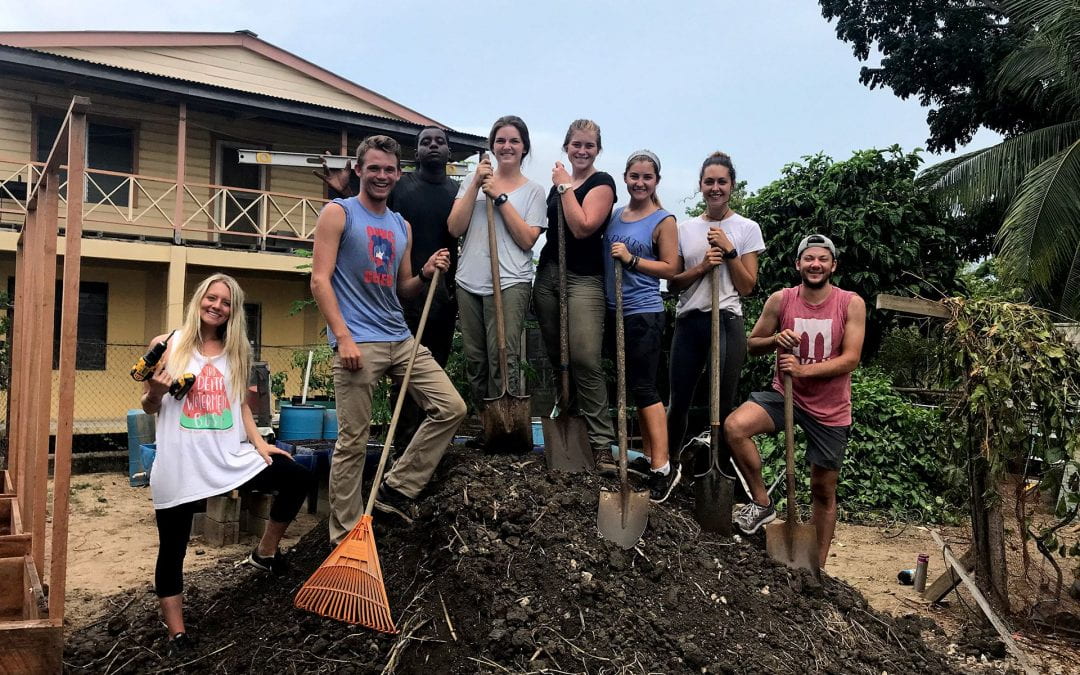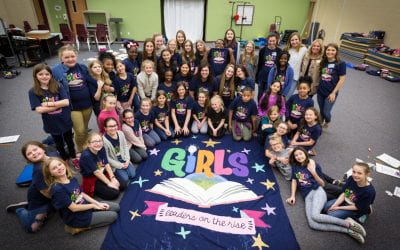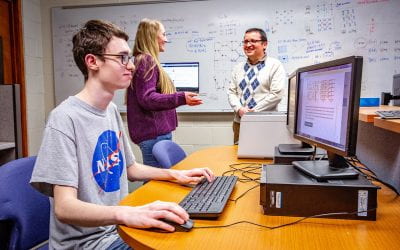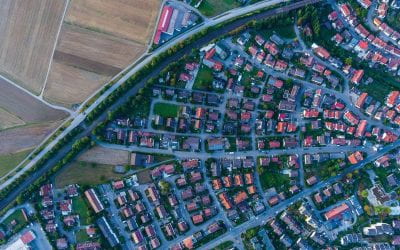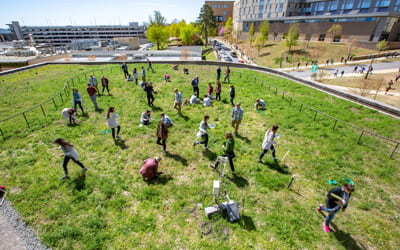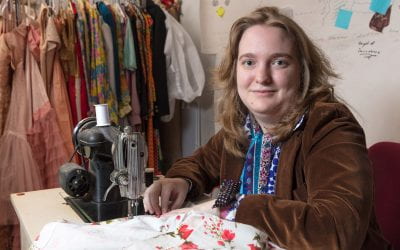The garden team tackles another pile of soil, with help from friends. Pictured (l-r): Madison Ermert, Zan Johnson, Alex Williams, Natalie Zimmerman, Bailey Carpenter, Dotty Fries, Lydia Adair and Tyler Reagan.
Model Garden to Boost Nutrition, Profits in Belize
By Katie Wilson Powell
A summer of beaches, tasty food, sunshine and a chance to serve. That’s the vision Zan Johnson, Bailey Carpenter, Natalie Zimmerman and Madison Ermert focused on as they tackled yet another pile of soil. Though the group anticipated unexpected adventures during the eight-week service-learning experience in Dangriga, Belize, they never dreamed of the sweat equity, sheer exhaustion and laughter that would accompany their journey.
Charged with designing a model backyard garden that could feed families and raise a little extra cash, the team jumped in with both feet. They landed in a combination of chicken litter and soil, part of an effort to recycle waste to maximize yield. “We hated that pile of dirt,” joked Bailey Carpenter, an animal science major. She focused on researching poultry feed and monitoring the overall health of the chickens. Ermert, an international business major with a concentration in development, surveyed community members about their diet with the goal of providing nutritional information. Zimmerman, an international business major with a focus on economics, brought business expertise to the project, outlining the budget and available resources. Johnson, an industrial engineering and economics major, provided plans and built structures for the garden and chicken coops, while also helping to evaluate the overall sustainability of the project. Their different backgrounds and goals coalesced into a manual that will be used by single mothers in need of additional at-home income.
The team got up with the sun, worked in the garden, and helped each other on their respective projects. “When I’m in a classroom setting and I hear group project I think…ehhh. But when you have people who are all working toward the same goals, who genuinely want to make a difference, a group project becomes what it is supposed to be,” Carpenter said. An added twist: They conducted this work independently of in-country faculty oversight. Though economics professor Amy Farmer, thesis director for three of the four students and founder of the Belize partnership, was readily accessible, the team had to decide how to make decisions and form relationships in the community. While this independence presented challenges, the team supported each other and took turns filming chicken biopsies, distributing surveys, and moving coops.
“One thing that I felt was so important about this trip was the length. Being there for two full months made what we were doing seem so much more impactful,” said Johnson. All four cited the importance of total immersion to the overall success of their work. “Most groups that come to Belize are doing short-term, one-off projects. They give many things, and leave. Though this starts with the best of intentions, it tends to perpetuate the cycle of aid,” said Zimmerman. At first, Dangriga residents did not know what to think of such a long-term, invested project. “When I was doing the surveys,” Ermert explained, “there were a few times that they said, ‘oh—you’re still here!’ I think we gained their respect when they saw that we were there, we were sweating right alongside them.”
The university’s ties to Belize date back to 2007, when Honors College funding helped launch service learning there. Since that time, with student participation frequently funded by Honors College grants, the Belize program has grown to include faculty-led study abroad and independent service-learning research like the model garden project. “These students come away from this with so much more than they give,” said Amy Farmer. “To be there without me…is the point. To me, it’s a level of learning and application that really puts them out of their comfort zone and engages them in a different type of critical thinking.”
More Field Notes
Girl Power
Close to 40 fifth-grade girls are getting their ya-yas out as they try to maneuver an Oreo from forehead to open mouth – no hands allowed. The exercise invokes chaos, and more than a few cookies crushed underfoot, but the girls are quick to settle into a large circle anchored by Sophia Vincent, an honors education senior who easily commands the room.
Thin Tin
Two Honors College students have tackled – and solved – an important question about matter that sheds new light on the quantum world. Guided by mentor Salvador Barraza-Lopez, associate professor of physics, students Tyler Bishop and Erin Farmer have uncovered new information about tin oxide and have published their research in Physical Review Letters.
Rethinking Suburban Sprawl
David Sweere grew up in a classic American suburb in Maumelle, Arkansas, in a single-family home on a corner lot. He recalls a lot of lawn mowing and the fact that “you could see the Kroger grocery store from my house, but you couldn’t walk to it.” Fast forward through eight years of far-flung military service and six years of architecture school, and Sweere is ready to roll up his sleeves and redesign suburban sprawl.
Meet Rufus, Your Friendly Campus Green Roof
They’re strange bragging rights – but then again, it is a roof talking. And not just any roof – the U of A’s Hillside Auditorium green roof, which is exactly what it sounds like: a roof covered in about five inches of soil, atop which native plants have been growing since March 2013. The roof, affectionately dubbed “Rufus” by its student supervisors, has been tweeting measurement updates since early February 2019 via a Raspberry Pi microcomputer, thanks to senior Zack Wofford. Wofford was inspired by a tweeting tree he encountered while studying abroad in Ghent, Belgium.
On the Fashion of the Noldor in the First Age
Whether you’re a fan of Tolkien’s Middle Earth or have simply absorbed the cultural references it spawned (my precious…) you likely have a strong mental image of Tolkien’s characters. Galadriel, for example: Cate Blanchett, clad in white and silver, with flowing sleeves and Y-shaped fabric sash. Given the popularity of Peter Jackson’s film trilogy, that’s completely to be expected. But it’s also a problem, says Elkins native Grace Costello, who graduated in December 2018 with a degree in costume design from the Apparel Merchandising and Product Development program in the School of Human Environmental Sciences.


“When I’m in a classroom setting and I hear group project I think…ehhh. But when you have people who are all working toward the same goals, who genuinely want to make a difference, a group project becomes what it is supposed to be.”
 The finished manual will be tested by the 2019 group of students who participate in the Belize program, who are building several gardens. The hope is to refine the manual to the point that profitable backyard gardens are fully sustainable without the presence of U of A students. As for the team? Zimmerman and Ermert plan to teach in foreign countries, Johnson will be continuing his service work as president of the Volunteer Action Center, and Carpenter is off to vet school at UPenn. All agree that this project has shaped both their careers and their idea of service. “My perception of service and the importance of it was changed through this opportunity,” Johnson said. “Trying to give back no matter where you are, understanding the impact you can make through culture and community, is something I’ve tried to expand on here and will continue to do wherever I go.”
The finished manual will be tested by the 2019 group of students who participate in the Belize program, who are building several gardens. The hope is to refine the manual to the point that profitable backyard gardens are fully sustainable without the presence of U of A students. As for the team? Zimmerman and Ermert plan to teach in foreign countries, Johnson will be continuing his service work as president of the Volunteer Action Center, and Carpenter is off to vet school at UPenn. All agree that this project has shaped both their careers and their idea of service. “My perception of service and the importance of it was changed through this opportunity,” Johnson said. “Trying to give back no matter where you are, understanding the impact you can make through culture and community, is something I’ve tried to expand on here and will continue to do wherever I go.”
This research was supported by an Honors College Extended Research Travel Grant; Madison Ermert also received a SURF Grant.

